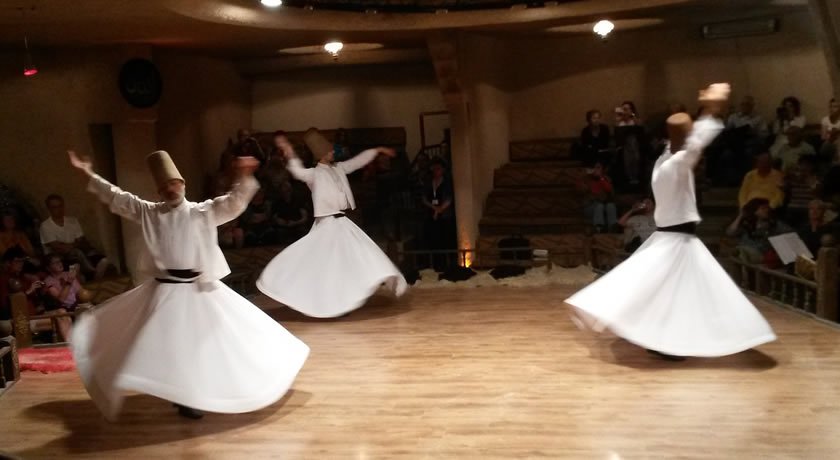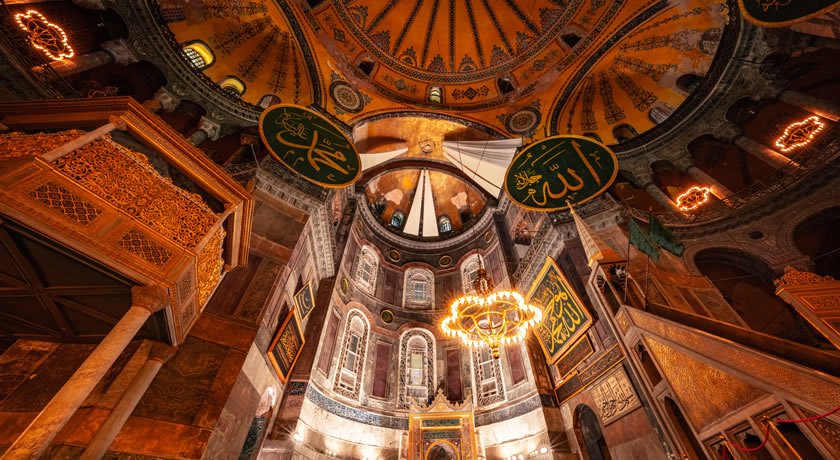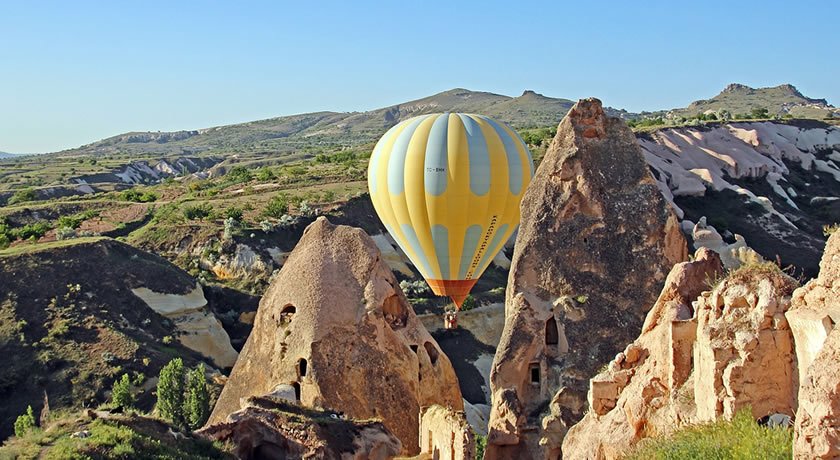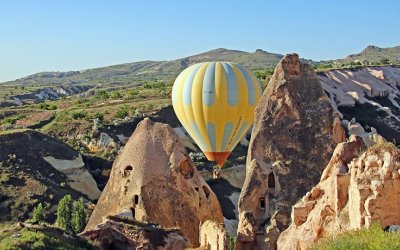
4. Group 12.04.2024
12.04.2024 | Certain Departure4. Group 12.04.2024
In The Lonely Trail Of St. Paul with Seven Churches of Revelation in Anatolia 2024
”In journeys often, in perils of waters, in perils of robbers, in perils by mine own countrymen, in perils by the heathen, in perils in the city, in perils in the wilderness, in perils in the sea, in perils among false brothers. ( 2 Corinthians 11:26) St. Paul was born a Jew of the tribe of Benjamin in Tarsus about AD 10 and spent his early years here. His father was a Roman citizen; St. Paul inherited that citizenship and its rights. (Acts 21:39) Then he was sent to Jerusalem to study. St. Paul spent most of his Christian life traveling over thousands of miles by land and sea, facing endless difficulties. These journeys were a great hardship for St. Paul who had to cover most of the area on foot. Our journey through the same routes will not be as difficult.
Turkey builds on an old and rich history through thousands of year’s history and variety of different cultures. It represents mixture of hundreds of cultures, stretching across the Anatolian peninsula in Western Asia and Thrace in the Balkans. The Anatolian peninsula is one of the oldest continuously inhabited regions in the world according to the archeological excavations.
Turkey is the land where Alexander the Great slashed the Gordian Knot, where Achilles battled the Trojans in Homer’s Iliad, where the first coin was minted in Sardis and where the Ottoman Empire fought battles that shaped the world and finally modern Republic of Turkey since 1923. The country is the haven of two of the world’s seven wonders: the temple of Artemis, and the Mausoleum of Halicarnassus. History buffs can plunge in marvels and souvenirs stretching back to the dawn of civilization. Nature lovers can enjoy the amazing mountain views and forests of the Black Sea region, as well as the astonishing beaches and natural wonders of the Aegean and Mediterranean shores.
Any visitor to Turkey will be struck by the multicultural and variety of historical not least religious and historical monumental buildings of the ancient shrines and cities. There are temples dedicated to ancient goods and goddess, churches of many denominations, synagogues and mosques. As civilizations succeeded each other for thousands of years and they left their religious legacy. After the monotheistic domination of Anatolia, Judaism Christianity and Islam co-existed in harmony.
One of Turkey’s most important features is Turkey’s capacity for synthesis, which is a historical inheritance. Such a rich history has left an unforgettable mark and Turkey flourishes with historic sites and archaeological wonders set in a diverse and beautiful landscape.
Now it is your turn to discover and experience Turkey through a very unique , professionally and academically designed itinerary with biblical historical , cultural social and economic not least Turkey ‘s geostrategic aspects in order to understand , explore of past , presence and future.

DAY 1-3 ISTANBUL
Our Accomodation Options
www.themarmarahotels.com
www.cpoldcity.com
www.titanic.com.tr
www.eliteworldhotels.com.tr
Day 1 -Arrival Istanbul Arrival at Istanbul Airport
Upon arrival to Istanbul and custom clearance You will be met by your Local Tour Leader and transferred to your hotel. After check in we will have a welcome meeting - cocktail and brief information meeting. Dinner and Overnight in Istanbul. (D)
Day 2 Istanbul Full Day Old City Tour
Breakfast at the hotel. We begin our day with a tour of the Sultan Ahmed square, located at the heart of the “Old City” from where the Byzantine and the Ottoman Empires were ruled from. We will walk the Hippodrome square, which was the epicenter of the sportive events and political activities of Constantinople in Roman , Byzantium and Ottoman periods. We will see and talk about the histories of the Obelisk of Theodosius, the Serpentine Column and the German Fountain of Wilhelm II. Then we take a short walk to the Blue Mosque, famous with its blue Iznik tiles and with its unique 6 minarets, built in the early 17th century. Next we visit the Hagia Sophia, one of the greatest marvels of the art & architecture history, constructed as the patriarchate cathedral in the 6th century by the Emperor Justinian. Lunch in a local restaurant. After lunch our next stop will be the Topkapi Palace complex with beautifully decorated gardens and impressive examples of Turkish architecture that housed the Ottoman Royalty and their unprecedented collections of imperial treasury, Chinese porcelains, weapons, calligraphy, and holy relics for over four centuries. The final destination of the day will be the narrow alleys of the Grand Covered Bazaar for exploring its maze of 4000 shops for an authentic oriental shopping experience. Dinner and Overnight in Istanbul.(B, L, D)
Day 3 Istanbul Full Day Bosphorus & City Tour
Breakfast at the hotel .We start our tour with a panoramic drive along the old city walls dating back to the 5th century and renowned as one of the greatest examples of a fortification system ever build to defend a city. Next; a short drive to Chora Museum,( *Chora is under restoration right now and if it is not opened yet then there will be a presentation of Chora Museum) a small church that was decorated with the most beautiful biblical mosaic panels and frescoes in the 14th century. After visiting the Chora we will be heading towards a 17th century mall called ‘the Egyptian Spice Bazaar’ which still functions as a spice and dried foods market with mystical smells and aromas, spreading around from hundreds of shops selling spices, fruits, vegetables, nuts, flowers, fish… Free time will be allocated for shopping in this bazaar. Lunch in a local restaurant. We end the day up with a relaxing Bosphorus Cruise, through the waterway separating the two continents, Asia and Europe, with its picturesque views of marble palaces, 15th century castles and ancient wooden mansions of the Ottoman architecture. Dinner at a local restaurant. Overnight in Istanbul. (B, L, D)

DAY 4-5 NICEA - TROYA
Our Accomodation Options
www.kolinhotel.com
www.parionhotel.com
DAY 4 Istanbul –Iznik (Nicea )-Bursa and Çanakkale
After the breakfast, we leave Istanbul behind us and drive to Nicaea. Nicaea was the venue for the first and the last Ecumenical Councils, meetings of representatives of all Christian churches. The first Ecumenical Council was held in Nicaea in 325. At the main crossroads of Iznik is the Church of St. Sophia which is museum now. The church was built in the 4th century and has a mosaic floor which dates to the 6th century. All gates and walls date from the Byzantine times. This is the building in which the Seventh–and last–Ecumenical Council was held in 787. The Nicaean Creed which is recited by many Christians as their belief, was first formulated by the bishops in Nicaea in AD 325. The Nicaean Creed “I believe in one God, the Father, the Almighty, maker of heaven and earth, and of all that is seen and unseen. I believe in one Lord, Jesus Christ, the only Son of God, eternally begotten of the Father. Light from Light, true God from true God, begotten, not made, one in being with the Father …….” In the 16th century ceramists in Nicaea ( Iznik) created the most beautiful Turkish Tiles ever made in Turkey. We will have some time to see unique Nicaean ( Iznik) Tiles in Cappadocia where the paradise of Nicaean and all tiles production in Avanos Cappadocia. Dinner and overnight in Canakkale. (B,L,D)
DAY 5 Çanakkale –Troja – Pergamon – Tyatria and Kusadasi
Breakfast at the hotel. Short coach drive to the world famous ancient city of Troy. Referred to in Homer’s “Iliad” and “Odyssey”, Troy has in fact nine cities superimposed one upon another. Troy VI pertains to the famous Trojan War of Homer where the legendary heroes such as Agamemnon, Achilles, Ulysses, and Nestor on the Greek side and Priamos, Hector, and Paris on the Trojan side. We will drive by Alexandria Troas, St. Paul preached here and climbed down to the little port on the shore to board the boat on his return journey to Jerusalem. Next we drive to the hauntingly beautiful Pergamum. Pergamum’s place in religious history is largely because of the paragraph addressed to its Christian believers by St. John in the Book of Revelation (Rev. 2:12-17). He characterized Pergamum as the place where Satan was enthroned. (Revelation 2:13)
St. John saw a group he called the Nicolatinas as an additional threat to the believers. Who these people were is not clearly known. (Revelation 2:14-15)
St. John condemned them for adultery and for eating food that had been sacrificed to pagan gods. St. John also promised a white stone and hidden manna to those who repented of their false beliefs and immoral behavior (Revelation 2:16-17).
Pergamum also houses; the remains of the Great Altar of Zeus, the Temple of Trajan and the steepest theater building ever, overlooking the plains of Bergama. Another highlight of The "Red Basilica" also called variously the Red Hall and Red Courtyard, is a monumental ruined temple in the ancient city of Pergamum, now Bergama, in western Turkey. The temple was built during the Roman Empire, probably in the time of Hadrian and possibly on his orders. It is one of the largest Roman structures still surviving in the ancient Greek world. We will check-in to our hotel in Kusadasi for dinner and overnight (B, L, D)
Bergama Asklepion (Pergamon Asclepeion)
The Bergama Asclepius (Pergamum Asclepius ), an ancient medical center honoring the Greek god of healing Asclepius, has existed since the 4th century BC when it was built in the ancient city of Pergamum (now Bergama). Built around a spring with waters that were believed to be sacred, the columns and walls still standing today once surrounded rooms for psychotherapy, massage, herbal remedies, baths, mud treatments and dream interpretation.
The Roman period brought the Asclepius its most notable patients, including emperors Marcus Aurelius and Hadrian. The influential physician Galen, who wrote about 500 works on medicine, practiced here in 2 AD.
Enter the structure as health seekers once did through the Sacred Way, a path that connects to the Acropolis. In the first courtyard there is an altar featuring a serpent, the emblem of modern medicine, and other structures include a small theater, a library and the circular domed Temple of Asclepius.
The Red Basilica of Pergamon
Archaeological excavations have begun focusing on the basement of the Red Basilica, one of the seven churches in Bergama, which is on UNESCO’s World Heritage List, and is one of the tallest surviving structures in Anatolia.
The basilica is called the “red courtyard” by people because of its large courtyard and the whole structure being made up of red brick. The basilica, at 19 meters’ height, is considered a magnificent religious structure and is one of the tallest among the Roman-era structures in Anatolia.
The basilica was built at the time of Emperor Hadrian in the 2nd century A.D. and is believed to have been dedicated to the Egyptian gods Serapis and Isis. It was later extended with additional buildings and became a religious center for Christians. Dinner and overnight in Kusadasi (B,L,D)

DAY 6-8 EPHESUS - HOUSE OF THE VIRGIN MARY
Our Accomodation Options
www.fantasia.com.tr
www.wyndhamresidenceskusadasi.com
www.richmondhotels.com.tr
www.kusturclub.com
DAY 6 Kusadasi Ephesus–Basilica of St. John–House of Virgin Mary
This morning we will stop by the Basilica of St. John “The Evangelist” who came here with Virgin Mary and wrote his Gospel in Ephesus. Then we will carry on to Ephesus ancient city. People visiting Ephesus today can visualize the city when it was the capital of the province. St. Paul preached and taught in Ephesus for over 2 years. During that time he sent Timothy and Erastus to Macedonia to continue the missionary work there. The names of several other early Christians are recorded as residents of Ephesus. Among them are the eloquent Apollos with whom St. Paul associated himself, saying that he planted, that Apollos watered, but that God gave the growth (I Cor. 3 :6)
A couple, Priscilla and Aquila, established a house church in Ephesus (I Cor. 16:19). The daughters of the Apostle Philip lived in Ephesus. A small stone building high up on the west corner of the city wall is pointed out as St. Paul’s Prison. He wrote the letter to the Ephesians from this place.
In Ephesus highlights include Double Church where in 431 the Third Ecumenical Council was held, the Library of Celcus, the Temple of Hadrian, the Fountain of Trajan and the Theatre for many Christians the best-known building in Ephesus where a 1st century AD silversmith attempted to stir up a riot to get rid of St. Paul who was damaging his business of making images of Artemis.
About 3 miles away in the forested mountain above Ephesus is the House of Virgin Mary. It is a modest stone house. St John brought Virgin Mary to Ephesus in keeping with Jesus’s admonition to him to care for his mother. (John 19:27)
House of Virgin Mary today is visited by almost a million pilgrims annually from all over the world. The pilgrims come to drink the waters of the sacred spring, to mediate, to pray for health, and to breathe the atmosphere of it. You will be able to collect some holly water from the Sacred Spring.
Both Pope Paul VI in 1967 and Pope John Paul II in 1979 have celebrated mass here.
Many people congregate at this sanctuary every August 15 to observe the Feast of the Assumption of the Virgin. It was first identified in 1818 by an Austrian nun, Anne Catherine Emmerich, who saw it in a dream exactly as it was found. The setting is beautifully peaceful, inspiring reverence and contemplation. Dinner and overnight in Kusadasi (B,L,D)
DAY 7 Kusadasi – Sardes – Philadelphia - Izmir Kusadasi
Departure from hotel after breakfast and drive to Sardis, whose history dates back to 12th century BC, was the capital of the ancient Kingdom of Lydia. In the book of Revelation (Rev. 3:1-6), St.John stated that Sardis needed to wake up. He complained that their acts did not live up to their reputation, that they did not finish what they started. But he held out the hope those who were not polluted that they should have robes of white (Revelation 3:5) White was the color then of righteousness and immortality.
Then we will drive by Philadelphia. During Byzantine times Philadelphia was the seat of a Christian bishopric. Its significance in Christian history was because it congregations addressed by St.John in the Book of Revelation (Rev. 3:7-13).
Although one of the Seven Churches, Philadelphia was the least distinguished; it was the only one about which St. John had no real criticism. He characterized it as having been given an open door. He told the Christians not to leave anyone take away their crowns and promised that those who were victorious would become pillars in God’s temple. “Hold fast to what you have, and let no one rob you of your crown” (Revelation 3:11). Dinner and overnight in Kusadasi (B,L,D)
DAY 8 Kusadasi – Hierapolis Pamukkale – Laodicea – Collesea
After breakfast we leave our hotel and drive to Hierapolis but before we get there we stop at Laodicea Ad Lycum. The site of one of the Seven Churches addressed by St.John in the Book of Revelation ( Rev. 3:14-22 ), Laodicea is on a low hill on the south bank of the Lycus River (Curuksu). As a commercial center,it had a large Jewish community. For St.John in Revelation, the Christians of Laodicea were neither hot nor cold and because of their indifference he wanted to spew them out of his mouth. “ I know all your ways, you are neither hot or cold. How I wish you were either hot or cold. Because you are lukewarm, neither hot nor cold, I will spit you out of my mouth” ( Revelation 3:15-17 ) St. John promised in “ the words of the Amen” (Revelation 3:14) that for those who were sensitive enough to hear and respond to what was being said, the Spirit would join them in the great feast. “Here I stand knocking at the door; if anyone hears my voice and opens the door, I will come in and sit down to supper with him and he with me “ ( Revelation 3:20) Then we will drive to Pamukkale and Hierapolis ancient city where St. Philip was martyred in 80 AD.. Recently Italian archaeologists have discovered his Martyrium, an octagonal chamber forming a double cross surrounded by a square. St. Philip lived here after the Apostles scattered from Jerusalem. Hierapolis is listed in the New Testament along with Laodicea as the center of Epaphras’s work ( Colossians 4:13 ).
Your tour in Pamukkale will include visits both to the Ancient city of Hierapolis with its staggering ancient necropolis and the picturesque cotton-white cascades of hot springs. Arriving to the hotel after a series photo breaks. Dinner and overnight in Pamukkale (B,L,D)

DAY 9-10 HIERAPOLİS - KONYA
Our Accomodation Options
www.richmondhotels.com.tr
www.hieraparkhotel.com
www.lycusriver.com
DAY 9 Pamukkale – Konya – Mevlana
After breakfast we leave our hotel and drive to Driving to Iconium (Konya ) , it has long been crossing point for many trade routes. Today its definition is its importance as a place of Christian and Muslim pilgrimage. Two thousand years ago Konya was called Iconium; St. Paul came here with Barnabas and preached here on his first missionary journey in 47 A.D. and Iconium became an important Christian city following St. Paul’s preaching’s. ( Acts 14: 1-6 ). They stayed in Iconium for some time and spoke so effectively that many people became Christian. St. Paul made two more stops here on his second and third journeys. Konya is a quite new city but the center of the city is very old. Before the end of the day; Visit the museum of Mevlana the founder of ‘Sufi’ wisdom and his Whirling Dervishes. Dinner and overnight in Konya . (B,L,D)
DAY 10 Konya to in Sultan Hani Kaymakli Cappadocia Pasabag (DAY 1 CAPP)
Departure from Konya after breakfast and drive to Magnificent Cappadocian Region so called ‘The land of the Beautiful Horses’ .Today we will be visiting one of the largest Caravanserai Sultanhani. Then drive to Today we visit one of the largest underground cities of Cappadocia: Kaymakli . This magnificent underground city is dating back to 3000 BC and eight storey deep. Thousands of early Christians had lived and took refuge in Kaymakli to survive against the persecution by the Romans. So far 36 underground cities are known in Cappadocia area. Then we will see fascinating commonly called “Fairy Chimneys” that are volcanic rock formations jutting out from the earth that have been shaped by the wind and rain. We will have some panoramic view stops in order to feel the landscape of Cappadocian formations. The Fairy Chimneys of Cappadocia are a striking example of how geography and human habitation have worked together, and how geography has influenced people’s imaginations. Dinner at hotel and overnight in Cappadocia. (B,L,D)

DAY 11-13 CAPPADOCIA
Our Accomodation Options
www.suhankapadokya.com
www.cpcappadocia.com
www.perissiahotel.com
urgup.dinler.com
DAY 11 Classical Day in Cappadocia (DAY 2 CAPP )
After an orientation drive around the picturesque sites and a few photo stops will arrive at the Uchisar Rock-Carved Castle overlooking the valleys and fairy chimneys of Cappadocia. Then we will proceed to the Open Air Museum of Goreme Valley to visit the rock carved churches hollowed out of volcanic ash, dating back to the IV-XIII centuries. Lunch will be at a local restaurant. Dinner and overnight in Cappadocia. (B, L, D)
DAY 12 Kapadokya (DAY 3 CAPP )
Today you can wake up early to join an optional activity any of the Cappadocian day ; a Hot Air Balloon ride before the breakfast which is by far the best way to enjoy the views of the lunar landscape of the region. Next take a short hike in Red Valley where you will be astonished by the view of the gorgeous rock formations in the tones of red. After the hike we drive to Mustafa Pasha (Sinasos), a lovely village with hundreds of years old stone houses. We will enjoy our lunch in a local restaurant which is established in one of those beautiful old houses here at Sinasos. To end the day we take the last drive around Cappadocia to the Pigeon Valley where local people had carved birdhouses on the cliffs to collect their droppings to use as fertilizer on their fields. Dinner and overnight in Cappadocia. (B, L, D)
DAY 13 Cappadocia - Antakya
After breakfast we will leave Cappadocia behind us on the way to Antioch, Biblical “Antioch on the Orontes”, Daphne and Seleucia Pieria. In Antioch, first to preach here was St. Peter followed by St. Paul and Barnabas whose extensive efforts proved to be very fruitful for Christianity. St. Peter was the first to establish a church in Antioch; this belief is based on the references in Acts 9:32 and in Galatians 2:11. Incidentally, the word Christians was first coined in Antioch. It was in Antioch that the disciples were first called the ‘Christians’ (Acts 11:26). Antioch served as the home base for St. Peter, St. Paul and Barnabas; shortly it became the third most important bishopric (after Jerusalem and Rome) in the developing church. Then we will go to to Seleucia Pieria that is mentioned in the New Testament only as the port from which St. Paul and Barnabas set sail for Cyprus on their first missionary journey. (Acts 13:4) Highlights include the museum which houses a superb collection of mosaics from Antioch, Daphne and Seleucia Pieria and St. Peter’s Grotto, the first Christian church where early Christians of Antioch met in secretly. .Dinner and overnight in Antioch . (B,L,D)

DAY 14-15 ADANA - HATAY
Our Accomodation Options
www.ramadaadana.com
www.divan.com.tr
www.anemonhotels.com
DAY 14 Hatay ADANA TARSUS
After breakfast we will see Antioch, Biblical “Antioch on the Orontes”, Daphne and Seleucia Pieria. In Antioch, first to preach here was St. Peter followed by St. Paul and Barnabas whose extensive efforts proved to be very fruitful for Christianity. St. Peter was the first to establish a church in Antioch; this belief is based on the references in Acts 9:32 and in Galatians 2:11. Incidentally, the word Christians was first coined in Antioch. It was in Antioch that the disciples were first called the ‘Christians’ (Acts 11:26). Antioch served as the home base for St. Peter, St. Paul and Barnabas; shortly it became the third most important bishopric (after Jerusalem and Rome) in the developing church. Then we will go to to Seleucia Pieria that is mentioned in the New Testament only as the port from which St. Paul and Barnabas set sail for Cyprus on their first missionary journey. (Acts 13:4) Highlights include the museum which houses a superb collection of mosaics from Antioch, Daphne and Seleucia Pieria and St. Peter’s Grotto, the first Christian church where early Christians of Antioch met in secretly. Drive to Adana for dinner and overnight. (B,L,D)
DAY 15 DEPARTURE DAY
Pre-RESERVATION DETAILS
4. Group 12.04.2024
14 Night 15 Day, transportation by Airplane, Bus
12.04.2024
Hotel
transportation by Airplane, Bus
2 Adult
One Shot (Cash)
 Highly secure online shopping with 256-bit encryption
Highly secure online shopping with 256-bit encryption












